7+ Sample Disclosure Agreements
-
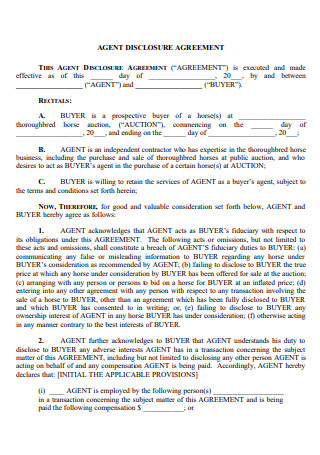
Agent Disclosure Agreement
download now -
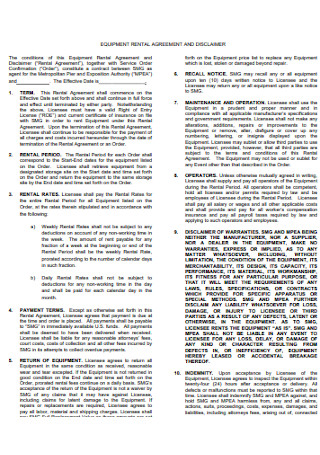
Equipment Rental Agreement and Disclosure
download now -
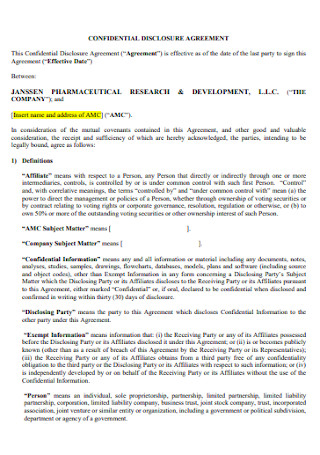
Confidential Disclosure Agreement
download now -

Sample Non Disclosure Agreement
download now -
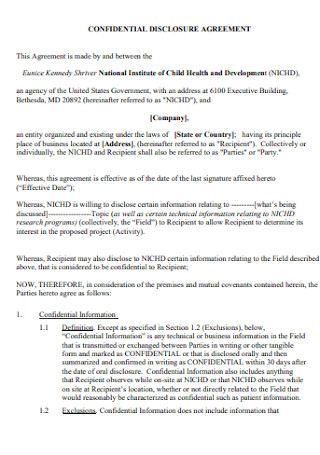
Confidentiality Disclosure Agreement
download now -
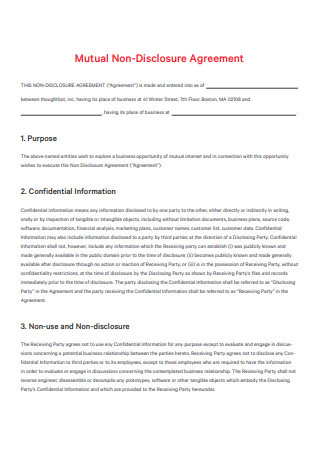
Basic Mutual Disclosure Agreement
download now -
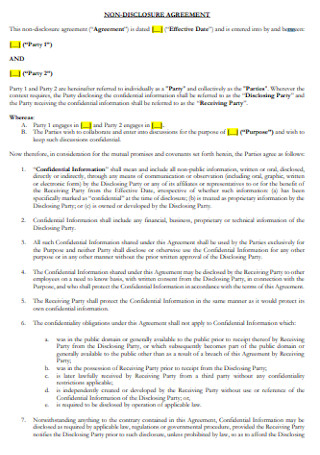
Disclosure Venture Agreement
download now -
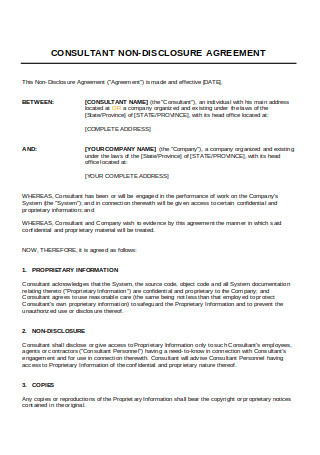
Consultant Non-Disclosure Agreement
download now
FREE Disclosure Agreement s to Download
7+ Sample Disclosure Agreements
What Is a Disclosure Agreement?
What Are Duties of Disclosure?
What Documents Should be Disclosed?
What Are Exceptions of Disclosure Agreement?
Common Fields of Full Disclosure
How to Prepare Disclosure Agreement
FAQs
When to Sign a Bilateral Nondisclosure Agreement?
What Do You Mean by Sample Confidentiality Agreement?
What Is a Mutual Non-Disclosure Agreement between Individuals?
A schedule of assets is typically attached to an incorporated prenuptial agreement as evidence that full disclosure was given and that the parties knowingly signed the agreement without being duped or deceived. It is, in essence, a legal agreement signed by a minimum of two individuals. There is a primary purpose for this document: to outline information that the parties are willing to communicate with one another for a specified purpose, but that must be prohibited from further use and dissemination. The parties agree that they will not divulge any of the confidential information included within the agreement. License Agreement Templates are also available for download.
What Is a Disclosure Agreement?
Generally, a disclosure agreement is a legal instrument that binds an individual, corporation, or other sorts of an organization to disclosing or sharing particular categories of information with the other parties who have agreed to participate in the disclosure agreement. It is the responsibility of government agencies to establish disclosure regulations that govern the breadth of information that can be required as part of a formal disclosure contract. Disclosure standards are in place in many nations. As a general rule, any type of disclosure agreement will impose restrictions on the types of information that must be disclosed, restricting the disclosure process to only material that is judged vital to the effective completion of the project that brought the parties together. An example of how a disclosure agreement works can be found in the real estate business, which is a common example.
In the majority of nations, sellers are required to provide particular information about the properties they are putting on the market. The general state of any structures on the site, any issues relating to the toxicity of the soil, and any other issues that buyers should be aware of in order to make an informed decision about acquiring the property are all included in this section. A seller’s failure to comply with the requirements of disclosure required by law may result in the transaction being unlawful, fines being levied by government agencies, and even the potential of a legal complaint being filed by the buyer against the seller. Other templates are available on our website, and you can use them whenever you need them. They are as follows: contract agreement, shareholder agreement, business lease agreement, sample unilateral non-disclosure agreement, negotiation of confidential disclosure agreement, sample mutual non-disclosure agreement, generic confidential disclosure agreement, service firm agreement, business agreement, employee non-disclosure agreement, and other similar template are available. This post will not only provide you with templates but will also provide you with important information that you need to know in order to complete your template.
What Are Duties of Disclosure?
The party that fails to comply with its disclosure obligations may be subjected to harsh sanctions by the judicial system. As a result, parties are encouraged to engage in discussions with other transacting parties about disclosure concerns in order to obtain an agreement on disclosure that is consistent with the criteria of proportionality and justice. The need to reveal information derives either from an agreement between the parties or through a court order, which can be selected from a menu of disclosure orders that include the following provisions:
- Order for the disclosure of a document on which a party depends, as well as the request for any specific disclosure required from the opponent.
- Order to carry out without disclosing anything.
- One problem at a time, the court orders the disclosure of records.
- A conventional disclosure order is one that is followed.
By reference, the order for disclosure that is selected will be the one that is appropriate for the complexity, character, and magnitude of the case at hand. The decision on whether a document should be revealed will be made in light of the grounds stated by the parties in their respective statement of the case.
What Documents Should be Disclosed?
In addition, the duty of document disclosure extends to papers under the control of a party, including documents that are or were in the physical possession of the party, which the party had the right to maintain or which the party had the right to examine. It also covers papers in the hands of an employee or the possession of an agency under the management of a third party. Documents held by the following entities may or may not be disclosed:
- Agents who are experts in their field
- Subsidiary firms are businesses that are separate from their parent company.
- Employees who have left the company.
In the context of disclosure requirements, the term “document” does not refer solely to material written on paper or to original copies of documents. It also contains information that has been stored electronically (ESI). The majority of the time, there will be ESIs that are relevant to a dispute, such as emails (including emails stored in a database and deleted emails).
What Are Exceptions of Disclosure Agreement?
Full disclosure necessitates the publication of all pertinent papers, regardless of whether they are confidential. In the case of “privileged” or sensitive material that has little or no connection to the dispute, the only exception is that it be disclosed. If such material is included with other needed information, it should be altered to ensure that it remains confidential.
Common Fields of Full Disclosure
The majority of businesses will be confronted with a full disclosure requirement at some time throughout their operations. Full disclosure is used in a variety of sectors, including the following:
How to Prepare Disclosure Agreement
Because of the full disclosure principle, corporations are legally obligated to share all of their financial information, including financial statements and any supporting documentation that could assist someone in better understanding the financial information. As a result, there is some wiggle room in terms of interpretation because, technically, this may cover a large quantity of data that the reader is unlikely to be interested in.
Step 1: Using the Phrase “Confidential” as a First Step
It should provide a clear definition of confidential. In most cases, this will contain financial information, customer and vendor lists, business ideas, unpublished patent applications, and other technical stuff.
Step 2: The Amount of Time During Which the Information Is Made Public
Information that is not divulged during the disclosure period is not considered to be protected by the confidentiality provision.
Step 3. Exclusions from the List
It is not acceptable to impose confidentiality limits in the following circumstances:
- The materials are not available to the general public at this time.
- The information was already in the possession of the party, or he obtained relevant knowledge of the contents from another source.
Step 4. The Responsibilities of the Recipient Party in Relation to Sensitive or Secret Information
The information shall only be used for the purposes that have been mentioned. People who are authorized to know about the information should be the only ones who have access to it. in relation to it is necessary to take reasonable measures to ensure that the information is kept safe. It should be assured that anytime the data is disclosed to anyone else, that person is held to the same standards of confidentiality. You may also want to look at the Basic Confidentiality Agreement.
Step 5. A Disclosure that Is Permissible
In some cases, nondisclosure agreements (NDAs) require that the receiving party provide the disclosing party advance notice that they are required to divulge the material as a result of legal proceedings or any court order. They should work with the party to ensure that judicial protection may be obtained for their actions.
Step 6. Do Not Include a Language Stating That the Information Will be Returned or Destroyed
Some nondisclosure agreements (NDAs) require that information be returned or destroyed upon the termination of the NDA. In the event that something goes wrong, this could result in a reduced level of legal protection. It is preferable to avoid including such a clause in your contract.
When it comes to investment opportunities, the concept of a disclosure agreement is very widespread. With regard to bond issues, entities that issue the bonds must give potential investors specified information that is considered significant to determining whether or not a bond issue has a high profit-making potential. If a municipality decides to create a bond issue to raise funds for the paving of streets in a new residential area, the city or town must provide specifics on how the purchase price of the bonds will be repaid, what will happen to the issue if the project is abandoned for any reason, and what will happen if unforeseen delays occur during construction. An investor can determine whether or not participating in the bond issue is a good idea based on the various outcomes, or whether or not he or she would be more comfortable investing in another sort of securities.
FAQs
When to Sign a Bilateral Nondisclosure Agreement?
A bilateral nondisclosure agreement is a mutual agreement that states that the parties involved will be disclosing information, but that the information will be kept confidential at all times.
What Do You Mean by Sample Confidentiality Agreement?
A Model Confidentiality Agreement is provided below (NDA) A confidentiality agreement (also known as a nondisclosure agreement or NDA) is a legally binding contract in which a person or corporation agrees to treat specified information as a trade secret and agrees not to disclose the secret to others without the prior written consent of the other party.
What Is a Mutual Non-Disclosure Agreement between Individuals?
A nondisclosure agreement is a contract between individuals that analyzes a possible arrangement that can benefit both sides in the long run. A non-disclosure agreement (NDA) is extremely popular among firms, entrepreneurs, and businesses since it allows them to begin licensing discussions, negotiations, and other future business agreements without disclosing their identities. In order to legally protect highly sensitive information, such as technological advances, trade secrets, and customer lists, an NDA must be signed by all parties involved. In other words, the receiving party is ensuring the disclosing party that they will not disclose any sensitive information to any third parties without their permission.
Even in job circumstances, an applicant is typically required to sign a disclosure agreement, which requires him or her to disclose specific types of information about his or her education, criminal past, and other important aspects of his or her background. At the same time, it is common for employers to be prohibited from requiring information such as religious preference or sexual orientation as part of the employee disclosure process. If an employer later discovers that an employee failed to disclose information that was specifically required by the provisions of the disclosure contract, disciplinary action, up to and including termination of employment, may be taken against the employee.
